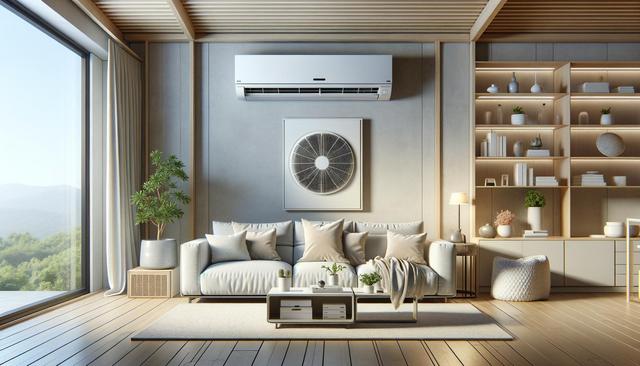Understanding How Ductless AC Works
Ductless air conditioning systems, often referred to as mini-splits, operate by connecting an outdoor compressor to one or more indoor air handling units via a small conduit. Unlike traditional systems that rely on a network of ducts to distribute air, ductless systems deliver cooled or heated air directly into each specific zone. This setup allows for a more targeted approach to climate control, making it ideal for homes without existing ductwork or for room additions where extending ducts would be impractical. If you’re curious about how ductless AC works, it’s essentially a two-part system using refrigerant to absorb and release heat, similar to central AC, but without the need for ducts.
Each indoor unit can be controlled independently, which means individual temperature settings for different rooms. This zoned approach not only enhances comfort but also contributes to energy savings, as you’re not cooling unused spaces. The ability to install units in various configurations—wall-mounted, ceiling-recessed, or floor-standing—adds flexibility to the system design.
Energy-Efficient Benefits of Ductless Systems
One of the most compelling reasons homeowners opt for ductless AC is energy efficiency. Traditional ducted systems can lose up to 30% of energy through leaks and poor insulation in the ducts. Ductless systems eliminate that problem entirely. Modern systems are designed to meet or exceed energy efficiency standards, making them a strong option for reducing utility bills and environmental impact. Many energy-efficient ductless systems also feature inverter technology, which adjusts the compressor speed in real time to maintain a consistent temperature, reducing the energy wasted during start-up cycles.
Other energy-saving features include:
- Programmable timers for scheduled operation
- Sleep modes that gradually reduce energy use overnight
- Eco modes that optimize performance based on ambient conditions
These features make ductless systems not only cost-effective in the long run but also an environmentally conscious choice for modern homes.
Evaluating the Cost of Ductless AC Installation
One important factor to consider before making the switch is the cost of ductless AC installation. While the initial investment may be higher than some window or portable units, it’s often more affordable than installing a full central AC system with new ductwork. Installation costs vary depending on the number of indoor units, the complexity of the setup, and the brand or model chosen.
Additional cost factors include:
- Electrical work needed to support the system
- Wall modifications for mounting units
- Labor fees charged by HVAC professionals
Some homeowners offset the upfront expense through local energy rebates or incentives for installing energy-efficient ductless systems. Over time, the energy savings and increased home value can help justify the investment.
Routine Ductless AC Maintenance Tips
To keep your system running efficiently and extend its lifespan, regular upkeep is essential. Fortunately, ductless AC maintenance tips are generally straightforward. Homeowners can perform some basic tasks themselves, while others should be handled by a licensed technician.
Key maintenance practices include:
- Cleaning or replacing air filters every 4–6 weeks
- Wiping down indoor units to prevent dust buildup
- Inspecting the outdoor unit for debris or blockages
- Scheduling annual professional service to check refrigerant levels and system performance
Neglecting maintenance can result in reduced efficiency, higher energy bills, or even premature system failure. Sticking to a regular maintenance routine ensures your ductless AC continues to perform effectively year after year.
Troubleshooting Common Ductless AC Issues
Even high-quality systems can experience occasional issues. Understanding the basics of troubleshooting ductless AC issues can help you identify problems early and decide when to call a professional. Some common signs of trouble include unusual noises, reduced airflow, or inconsistent temperatures between zones.
Before reaching out to a technician, try these simple checks:
- Ensure the remote control batteries are functional
- Verify that the circuit breaker hasn’t tripped
- Check air filters for clogs or dirt
- Inspect outdoor unit for ice buildup or debris
If these steps don’t resolve the issue, it may indicate a more complex problem such as a refrigerant leak, sensor malfunction, or compressor issue. In such cases, professional diagnostics and repair are necessary to prevent further damage.
Conclusion: Why a Ductless AC Upgrade Makes Sense
For homeowners looking to improve comfort without the hassle of duct installation, a ductless AC upgrade offers a practical and energy-conscious solution. With flexible installation options, zoned temperature control, and efficient performance, these systems are well-suited to a wide range of home layouts and climates. As long as you understand the cost of ductless AC installation and commit to regular ductless AC maintenance tips, the benefits are long-lasting. Considering the availability of energy-efficient ductless systems and support for troubleshooting ductless AC issues, it’s easy to see why so many homeowners are turning to this alternative. Whether you’re exploring how ductless AC works or researching the best ductless AC brands, there’s a solution that can meet your needs and enhance your home’s comfort.




Leave a Reply